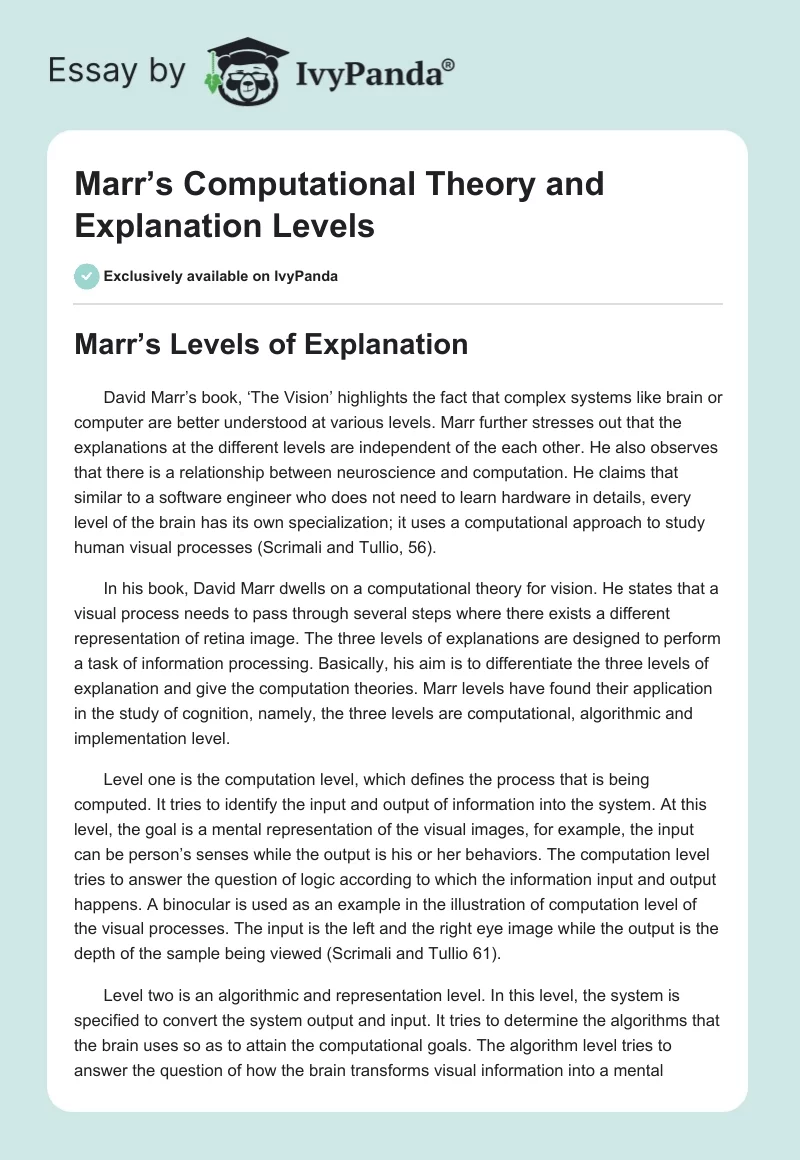Marr’s Levels of Explanation
David Marr’s book, ‘The Vision’ highlights the fact that complex systems like brain or computer are better understood at various levels. Marr further stresses out that the explanations at the different levels are independent of the each other. He also observes that there is a relationship between neuroscience and computation. He claims that similar to a software engineer who does not need to learn hardware in details, every level of the brain has its own specialization; it uses a computational approach to study human visual processes (Scrimali and Tullio, 56).
In his book, David Marr dwells on a computational theory for vision. He states that a visual process needs to pass through several steps where there exists a different representation of retina image. The three levels of explanations are designed to perform a task of information processing. Basically, his aim is to differentiate the three levels of explanation and give the computation theories. Marr levels have found their application in the study of cognition, namely, the three levels are computational, algorithmic and implementation level.
Level one is the computation level, which defines the process that is being computed. It tries to identify the input and output of information into the system. At this level, the goal is a mental representation of the visual images, for example, the input can be person’s senses while the output is his or her behaviors. The computation level tries to answer the question of logic according to which the information input and output happens. A binocular is used as an example in the illustration of computation level of the visual processes. The input is the left and the right eye image while the output is the depth of the sample being viewed (Scrimali and Tullio 61).
Level two is an algorithmic and representation level. In this level, the system is specified to convert the system output and input. It tries to determine the algorithms that the brain uses so as to attain the computational goals. The algorithm level tries to answer the question of how the brain transforms visual information into a mental representation of 3D image. For example, the binoculars stereopsis has stereo algorithms as their input. The course algorithm computes the blurred image of the depth into input image at a finer scale (Scrimali and Tullio 70).
Level three is an implementation level. It tries to comprehend how the algorithm is grasped into the physical structure in the mind. It tries to answer the question how the system is physically comprehended. An example is the computer hardware or neuron cells in the brain. Sensitive neurons have been identified to be in action in the brain, closer to the input or output stage (Scrimali and Tullio 74). David Marr’s approach on vision provides a framework which is both computationally traceable and biologically plausible in the understanding of human vision.
Marr’s Methodology and a Reductionist View of the Relation Between Psychology and Neuroscience
There are concerns on the Marr’s computational theory. The name computational theory has been found to be misleading as the researcher does not explain the computational procedures. He only explains the tasks to be performed by the computation system. Marr’s analysis is questioned by David Broadbent who claims that, connectionism in psychologist analysis of Marr’s implementation level is irrelevant to psychology.
David Marr algorithms and cognitive representations focus rather on the nature of problems than on the mechanism and hardware in which they are embodied. Many philosophers recommend a study of human hardware so as to understand the judgments and common sense concepts. There are questions on these levels where theorizing and research is a concern for psychology. There is some controversy between mentalism and behaviorism on suitable level of analysis (Baars, 281).
There is a tension that exists on the reductionist view between neuroscience and psychology. Biological as well as social approaches to the behavior of humans have always been contrasted to one another. The two functions act as mutually exclusive or antagonistic entities. The underlying assumption in social neuroscience consists in the fact that the mechanisms behind the behavior and mind will never be entirely explicable by using social or biological approach in solidarity (Brain & Christine 129). Multilevel integrative scrutiny is needed; it can be added that the scientific language that is universal and fully grounded in the function and structure of the brain is highly crucial and important.
A human behavior is entirely biological at some levels. The biological reductionism gives rise to singular, simple, and satisfactory explanations on molecular representation forms, and complex behaviors are the source of the highest degree analysis that prompts the understanding of human behaviors (Brain & Christine 113).
In conclusion, it must be emphasized that connectionism models are built with similarity with neural processing. It is my opinion that they are suitable for representing the cognitive phenomena. The social sciences have developed a molar construct that is the prime source of understanding activities that are highly complex (Brain & Christine 136).
Works Cited
Baars, Bernard J, and Nicole M.Gage. Cognition, Brain, and Consciousness: Introduction to Cognitive Neuroscience. Amsterdam: Elsevier/Academic Press, 2010. Print.
Brain, Christine. Advanced Psychology: Applications, Issues and Perspectives. Cheltenham: Nelson Thornes, 2002. Print.
Scrimali, Tullio. Neuroscience-based Cognitive Therapy: New Methods for Assessment, Treatment, and Self-Regulation. Chichester, West Sussex: Wiley-Blackwell, 2012. Print.


